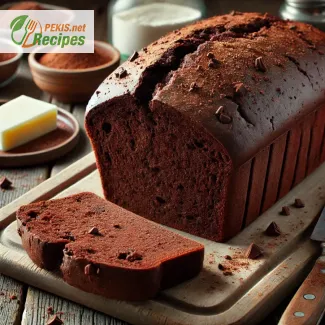
Chocolate Bread is a decadent, rich treat that brings the full-bodied taste of chocolate to the table in a heartwarming and soft bread loaf. Imagine slicing into a loaf of fresh, moist chocolate bread, with an aroma that fills the kitchen with the allure of melted cocoa and freshly baked warmth. This bread offers a deliciously indulgent twist on traditional quick breads, balancing the flavor profile between a rich chocolate cake and a comforting loaf of bread. Its smooth texture and subtle chocolate crumb are perfect for breakfast, as a snack, or even as a satisfying dessert. Each slice gives a satisfying bite, not overly sweet but with a natural, deep chocolate flavor that chocolate lovers crave.
Preparation and Storage Guidelines
One of the joys of chocolate bread is that it can be made up to three days in advance of any event, gathering, or special treat for family and friends. This bread maintains its moisture and softness even after a few days, making it convenient for those who like to prepare early or enjoy fresh snacks on hand. However, for the best texture and freshness, it’s recommended to enjoy the bread within the first two days after baking.
When preparing chocolate bread for serving, allow it to cool completely before slicing; this ensures clean, precise slices without crumbling. Serve it at room temperature to enjoy the full, complex flavor profile of the chocolate. Alternatively, you can warm it slightly in the oven or toaster for a few minutes to release its rich aroma and bring back that freshly baked feel. Add a touch of butter, a drizzle of chocolate syrup, or a dusting of powdered sugar for an elevated experience.
How to Store Chocolate Bread
To keep your chocolate bread moist and flavorful for as long as possible, it’s important to store it properly. Once it has fully cooled, wrap it in plastic wrap or place it in an airtight container to prevent drying. Store the bread at room temperature if you plan to consume it within 2-3 days. For those who want to extend its life, refrigeration is also an option. When stored in the refrigerator, the bread can last up to a week, though it’s best to let it sit out at room temperature for a few minutes before enjoying, as this helps bring back its soft texture.
If you’d like to make chocolate bread in bulk or save some for later, freezing is a fantastic option. Slice the bread and wrap each slice individually in plastic wrap before placing them in a freezer-safe bag. Frozen chocolate bread can be stored for up to 3 months. When you’re ready to enjoy a slice, simply thaw it at room temperature or give it a quick warm-up in the microwave or oven to revive its delightful taste and texture.
Chocolate bread is a versatile and rich treat that pairs beautifully with morning coffee, as a mid-day snack, or even as a decadent dessert. The deep chocolate undertones and soft, slightly dense crumb make it a must-try for anyone who loves chocolate. Whether you’re serving it at a gathering, gifting it to a friend, or simply treating yourself, this bread is sure to be a hit. With its easy storage, early preparation options, and deliciously indulgent taste, chocolate bread is a recipe to keep in your repertoire for any occasion where chocolate is the star.
- Preheat Oven: Set your oven to 175°C (350°F). Grease a loaf pan (about 20 x 10 cm or 8 x 4 inches) or line it with baking paper.
- Combine Dry Ingredients: In a large mixing bowl, whisk together the flour, cocoa powder, sugar, baking powder, baking soda, and salt until well combined.
- Prepare Wet Ingredients: In a separate bowl, whisk together the milk, melted butter, eggs, and vanilla extract until smooth.
- Mix Wet and Dry Ingredients: Gradually fold the wet ingredients into the dry ingredients. Mix until just combined; avoid overmixing to ensure the bread stays tender.
- Add Chocolate Chips: Gently fold the chocolate chips or chunks into the batter, distributing them evenly throughout.
- Transfer to Pan: Pour the batter into the prepared loaf pan, spreading it evenly.
- Bake: Place the pan in the preheated oven and bake for 50-60 minutes. To check for doneness, insert a toothpick into the center of the bread; it should come out clean or with just a few moist crumbs.
- Cool: Remove the pan from the oven and allow the bread to cool in the pan for about 15 minutes. Then, transfer it to a wire rack to cool completely.
Chocolate Bread: Nutritional Impact and Health Effects
Chocolate bread, while indulgent and delicious, offers a mix of nutrients that can be both beneficial and moderate in their impact on health. The balance of carbohydrates, fats, and proteins provides energy and satiety, while various minerals and vitamins contribute to essential body functions. With ingredients like cocoa, flour, milk, eggs, and chocolate chips, this bread can offer nutrients that aid bodily functions, though moderation is advised to prevent overconsumption of sugars and fats.
1. Carbohydrates and Energy
This bread’s carbohydrate content, mostly derived from flour and sugar, plays a significant role in delivering quick and sustained energy. Carbohydrates are the body's primary energy source, essential for mental alertness and physical stamina. Whole milk also adds lactose, a naturally occurring sugar that further contributes to energy levels.
However, it’s important to recognize that refined sugars, while satisfying our taste buds, can lead to rapid spikes in blood sugar followed by drops that can make us feel tired or hungry again. Including a protein source, like eggs in the recipe, can help moderate this effect by balancing sugar absorption, creating a more steady release of energy.
2. Proteins for Tissue and Muscle Health
Eggs are a central ingredient in this chocolate bread, providing high-quality proteins. Each egg contains essential amino acids that support tissue repair and muscle health, making chocolate bread a treat with added protein benefits. Proteins are critical for rebuilding muscle tissue, especially after exercise, and for maintaining healthy skin and hair. Each slice provides about 5 grams of protein, a modest addition to daily intake but helpful in balancing the meal.
3. Fats and Heart Health
With sources like butter and chocolate chips, this bread contains both saturated and unsaturated fats. The saturated fats, primarily from butter and dairy, should be consumed mindfully, as they can impact cholesterol levels if eaten excessively. However, moderate saturated fat intake, as part of a balanced diet, can support certain bodily functions, like hormone production and cellular structure.
The dark chocolate chips in the recipe contribute to unsaturated fats, particularly when using a high-quality dark chocolate. Unsaturated fats help reduce LDL (bad) cholesterol levels and support HDL (good) cholesterol levels, benefiting cardiovascular health. In addition, the natural antioxidants present in cocoa, like flavonoids, can improve blood circulation and heart function, aiding in long-term cardiovascular wellness.
4. Fiber for Digestion
This bread contains fiber, though not in high amounts. Cocoa and flour provide some fiber, supporting digestion by promoting healthy bowel movements and regulating blood sugar levels. Fiber also helps us feel fuller for longer, which can prevent overeating. Adding whole grain flour or oats to this recipe can enhance its fiber content, making it even more supportive for digestive health and blood sugar control.
5. Vitamins in Chocolate Bread
Chocolate bread offers a modest array of vitamins:
- Vitamin A: Present in butter and eggs, Vitamin A plays a role in eye health, skin repair, and immune support. It’s a powerful antioxidant that helps fight oxidative stress in the body.
- B Vitamins: The recipe provides several B vitamins, especially from eggs and milk. Vitamin B2 (Riboflavin) supports energy metabolism and skin health, while Vitamin B12 is critical for red blood cell formation and neurological function. These vitamins are water-soluble and play roles in converting food to energy, making them essential for anyone looking to maintain high energy levels and focus.
- Vitamin D: While found in smaller amounts, Vitamin D is present in eggs and fortified dairy products. Vitamin D supports calcium absorption, bone health, and immune function, particularly important in climates or seasons with limited sunlight exposure.
- Vitamin E: Cocoa powder contains Vitamin E, a fat-soluble antioxidant that supports skin health and protects cells from free radical damage. Vitamin E’s antioxidant properties are particularly beneficial for the heart and immune system.
6. Minerals for Bone and Heart Health
Calcium, iron, and magnesium are some of the notable minerals in chocolate bread, especially when made with milk, eggs, and cocoa.
- Calcium: Primarily sourced from milk, calcium is essential for bone density and heart health. It’s a vital mineral for muscle function and nerve signaling, and regular intake can reduce the risk of osteoporosis as we age.
- Iron: Present in cocoa, eggs, and enriched flour, iron is crucial for red blood cell formation and oxygen transport throughout the body. A diet with adequate iron levels supports stamina, brain function, and immune response.
- Magnesium: Found in cocoa, magnesium supports over 300 biochemical reactions in the body, including muscle and nerve function, blood glucose control, and energy production. Magnesium’s anti-inflammatory properties benefit cardiovascular health, especially when paired with the antioxidants in cocoa.
How Often Should Chocolate Bread Be Consumed?
As a treat that includes sugar and saturated fats, chocolate bread is best enjoyed occasionally rather than as a staple in the daily diet. Consuming chocolate bread once or twice a week allows for indulgence without overloading on sugars or fats. Portion control is essential—one slice can be an enjoyable treat that satisfies cravings and provides modest nutritional benefits without excessive calorie intake.
For those with active lifestyles, chocolate bread can offer a quick energy source pre- or post-workout, but it’s best paired with protein and fiber-rich foods to balance out sugar content and ensure sustained energy.
Enjoying Chocolate Bread Healthily
- Make Substitutions for Added Health Benefits: Swap out some all-purpose flour for whole wheat flour to increase fiber content. You could also use dark chocolate chips with a higher cocoa content for additional antioxidants and lower sugar.
- Add Nuts for Extra Protein and Healthy Fats: Walnuts, almonds, or hazelnuts complement chocolate flavors well and provide omega-3 fatty acids along with extra protein, making the bread more filling.
- Keep Portions in Mind: Chocolate bread is a satisfying, rich treat. Serving 1-cm slices helps in keeping portions moderate while still offering a fulfilling snack.
- Include Fresh Fruit: Serve with fresh strawberries or raspberries for a refreshing touch and a dose of Vitamin C, which enhances iron absorption from cocoa and flour.
Chocolate bread offers a wonderful blend of flavors and textures, but it’s best enjoyed as an occasional indulgence within a balanced diet. By being mindful of portions and incorporating simple ingredient swaps, chocolate bread can be both a nutritious and indulgent addition to your routine.
This recipe contains the following common allergens:
- Gluten (flour)
- Dairy (milk, butter, chocolate chips)
- Eggs
Allergen Substitution Tips
- Gluten-Free: Replace all-purpose flour with a gluten-free flour blend that includes a stabilizer, such as xanthan gum, to mimic the texture.
- Dairy-Free: Substitute the milk with an equal amount of almond milk or oat milk and use coconut oil or a dairy-free butter alternative in place of butter. Ensure chocolate chips are dairy-free.
- Egg-Free: For each egg, use a “flax egg” by mixing 1 tbsp ground flaxseed with 3 tbsp water. Let it sit for a few minutes to thicken before adding to the mixture.
This Chocolate Bread can be a versatile addition to any dessert table or brunch, with simple adjustments making it accessible to a variety of dietary needs!





